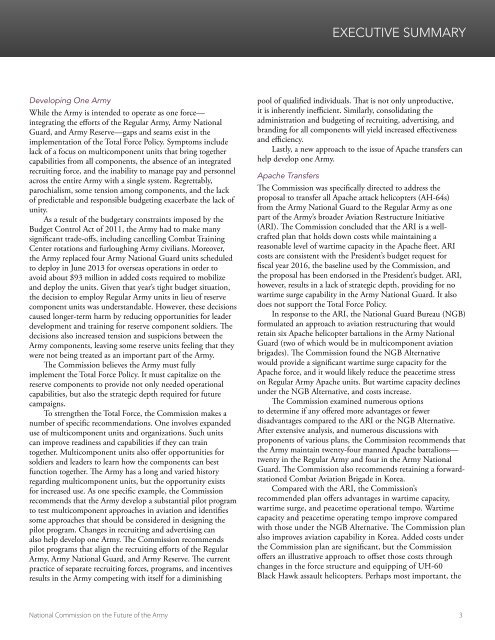THE FUTURE OF THE ARMY
NCFA_Full%20Final%20Report_0
NCFA_Full%20Final%20Report_0
Create successful ePaper yourself
Turn your PDF publications into a flip-book with our unique Google optimized e-Paper software.
EXECUTIVE SUMMARY<br />
Developing One Army<br />
While the Army is intended to operate as one force—<br />
integrating the efforts of the Regular Army, Army National<br />
Guard, and Army Reserve—gaps and seams exist in the<br />
implementation of the Total Force Policy. Symptoms include<br />
lack of a focus on multicomponent units that bring together<br />
capabilities from all components, the absence of an integrated<br />
recruiting force, and the inability to manage pay and personnel<br />
across the entire Army with a single system. Regrettably,<br />
parochialism, some tension among components, and the lack<br />
of predictable and responsible budgeting exacerbate the lack of<br />
unity.<br />
As a result of the budgetary constraints imposed by the<br />
Budget Control Act of 2011, the Army had to make many<br />
significant trade-offs, including cancelling Combat Training<br />
Center rotations and furloughing Army civilians. Moreover,<br />
the Army replaced four Army National Guard units scheduled<br />
to deploy in June 2013 for overseas operations in order to<br />
avoid about $93 million in added costs required to mobilize<br />
and deploy the units. Given that year’s tight budget situation,<br />
the decision to employ Regular Army units in lieu of reserve<br />
component units was understandable. However, these decisions<br />
caused longer-term harm by reducing opportunities for leader<br />
development and training for reserve component soldiers. The<br />
decisions also increased tension and suspicions between the<br />
Army components, leaving some reserve units feeling that they<br />
were not being treated as an important part of the Army.<br />
The Commission believes the Army must fully<br />
implement the Total Force Policy. It must capitalize on the<br />
reserve components to provide not only needed operational<br />
capabilities, but also the strategic depth required for future<br />
campaigns.<br />
To strengthen the Total Force, the Commission makes a<br />
number of specific recommendations. One involves expanded<br />
use of multicomponent units and organizations. Such units<br />
can improve readiness and capabilities if they can train<br />
together. Multicomponent units also offer opportunities for<br />
soldiers and leaders to learn how the components can best<br />
function together. The Army has a long and varied history<br />
regarding multicomponent units, but the opportunity exists<br />
for increased use. As one specific example, the Commission<br />
recommends that the Army develop a substantial pilot program<br />
to test multicomponent approaches in aviation and identifies<br />
some approaches that should be considered in designing the<br />
pilot program. Changes in recruiting and advertising can<br />
also help develop one Army. The Commission recommends<br />
pilot programs that align the recruiting efforts of the Regular<br />
Army, Army National Guard, and Army Reserve. The current<br />
practice of separate recruiting forces, programs, and incentives<br />
results in the Army competing with itself for a diminishing<br />
pool of qualified individuals. That is not only unproductive,<br />
it is inherently inefficient. Similarly, consolidating the<br />
administration and budgeting of recruiting, advertising, and<br />
branding for all components will yield increased effectiveness<br />
and efficiency.<br />
Lastly, a new approach to the issue of Apache transfers can<br />
help develop one Army.<br />
Apache Transfers<br />
The Commission was specifically directed to address the<br />
proposal to transfer all Apache attack helicopters (AH-64s)<br />
from the Army National Guard to the Regular Army as one<br />
part of the Army’s broader Aviation Restructure Initiative<br />
(ARI). The Commission concluded that the ARI is a wellcrafted<br />
plan that holds down costs while maintaining a<br />
reasonable level of wartime capacity in the Apache fleet. ARI<br />
costs are consistent with the President’s budget request for<br />
fiscal year 2016, the baseline used by the Commission, and<br />
the proposal has been endorsed in the President’s budget. ARI,<br />
however, results in a lack of strategic depth, providing for no<br />
wartime surge capability in the Army National Guard. It also<br />
does not support the Total Force Policy.<br />
In response to the ARI, the National Guard Bureau (NGB)<br />
formulated an approach to aviation restructuring that would<br />
retain six Apache helicopter battalions in the Army National<br />
Guard (two of which would be in multicomponent aviation<br />
brigades). The Commission found the NGB Alternative<br />
would provide a significant wartime surge capacity for the<br />
Apache force, and it would likely reduce the peacetime stress<br />
on Regular Army Apache units. But wartime capacity declines<br />
under the NGB Alternative, and costs increase.<br />
The Commission examined numerous options<br />
to determine if any offered more advantages or fewer<br />
disadvantages compared to the ARI or the NGB Alternative.<br />
After extensive analysis, and numerous discussions with<br />
proponents of various plans, the Commission recommends that<br />
the Army maintain twenty-four manned Apache battalions—<br />
twenty in the Regular Army and four in the Army National<br />
Guard. The Commission also recommends retaining a forwardstationed<br />
Combat Aviation Brigade in Korea.<br />
Compared with the ARI, the Commission’s<br />
recommended plan offers advantages in wartime capacity,<br />
wartime surge, and peacetime operational tempo. Wartime<br />
capacity and peacetime operating tempo improve compared<br />
with those under the NGB Alternative. The Commission plan<br />
also improves aviation capability in Korea. Added costs under<br />
the Commission plan are significant, but the Commission<br />
offers an illustrative approach to offset those costs through<br />
changes in the force structure and equipping of UH-60<br />
Black Hawk assault helicopters. Perhaps most important, the<br />
National Commission on the Future of the Army 3


